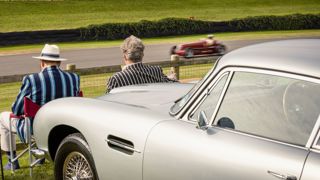Behind the wheel of Fangio’s championship-winning Alfa Romeo 158 | Frankel’s Insight
 Andrew Frankel
Andrew Frankel
It is the most important Alfa Romeo in the world. It is the car that won Juan Manuel Fangio his first Formula 1 World Championship in 1951; it is also the most recent Alfa Romeo to win an F1 race, despite the fact its design was nearly 15 years old at the time. The year before it won every single round of the inaugural Formula 1 World Championship (I’m not counting the Indy 500), a feat not repeated to this day. Or indeed the day a few years back when I got to drive it.

The Alfa 158/159 was conceived in 1937, designed mainly by the great Giacchino Colombo, to take part in the voiturette category of racing which permitted supercharged engines of up to 1.5 litres, half the size of then fully fledged Grand Prix machinery. It made its debut in 1938 and was dominant until global conflict put paid to its progress until 1946, a period in which race car development stood still. Picking up where it left off in 1946, it continued to reign supreme during the early days of F1 in the late 1940s and sail through the first season of the new championship essentially unopposed.
Revised with De Dion rear suspension and its name changed from 158 to 159 for 1951, it remained the fastest F1 car of its era. But its phenomenal thirst (and the additional pitstops it required) made it vulnerable to the new naturally-aspirated 4.5-litre Ferrari 375, meaning it won just four of the seven rounds that year, still enough to secure the title for Fangio. With a new 2-litre naturally aspirated formula mandated for 1952 rendering the 159s instantly obsolete, Alfa Romeo pulled out of F1 at the end of the year, allowing Ferrari to run riot for the next two seasons.
The car I drove was Fangio’s own 1951 machine, it having remained in Alfa ownership from then until now. It is utterly ferocious. When first raced in 1938, the blown straight eight 1.5-litre motor put out a little more than 203PS (149kW). By 1951 that number had approximately doubled to 431PS (317kW) at a fairly astonishing 9,300rpm. It weighs 700kg. It has a better power to weight ratio than a McLaren P1. With skinny tyres and drum brakes.
And if you think that makes it tricky to drive, be advised that both the pedals and four speed gearbox have reversed layouts, so the brake is to the right of the throttle and the third to fourth plane of the transmission to the left of the first to second. And the lever is down by your left thigh and can’t be seen when driving.
It takes no fewer than three sets of spark plugs individually tailored for their purpose, just to get it ready to run. One set is simply to fire it up, the next used while the car is sat waiting for the engine to reach correct operating temperature. Only then are cold plugs fitted for serious work. All the while you’re being slowly overcome by the sweet-smelling fumes from the blend of methanol, ether and castor oil on which it runs. How quickly does it get through this heady brew? At full racing speed, 2mpg is a distant dream.
There’s no legroom and the steering weight illustrates why the most successful drivers of this era tended to be quite short and built like bulls.
I’m waiting at the entrance to Alfa’s Balocco test track and ask how many laps I’m allowed. ‘As many as you need’. How many revs? ‘Ah, sorry, no more than this please.’ I follow the finger pointing at 8,500rpm, just 800rpm short of where Fangio would have shifted 74 years ago.

Most racing cars actually get easier the faster you go but not this one. The first thing that happens when you put your foot down is a howl from the engine so loud it occupies entirely the space between your ears. Next there is acrid smoke, some from the exhaust but also from the rapidly incinerating rear tyres. Finally there is barely describable thrust.
The supercharger has no means of moderating its boost so the more revs you use, the more power it produces. The steering feels vintage and the chassis balance such that it will understeer a little off the power and oversteer from here to eternity if you’re careless with the throttle. It doesn’t bite but juggling the backwards gears and pedals while it tries to reach escape velocity takes all the brain power I can summon. Brakes? What brakes? For the performance available, it barely has any at all.
Then just as I am starting to get confident in the car, the engine dies. I’ve been using all 8,500rpm in every gear and maybe it’s been too much for the old girl. But mercifully it’s the fuel not oil pressure that’s died. I’ve run the tank dry in just half an hour. It was enough: just to have sat in Fangio’s seat would have been an impossible privilege. To be allowed to drive it like as fast as I could make it go still seems a dream. Without the photographs to prove it, I might now think it was.
Alfa Romeo
F1
Grand Prix
Race
Frankels Insight
historic
-

GRRC Ultimate Access Package
-

GRRC Lavant Bank Parking
-

The Gordon Pavilion
-

GRRC Ultimate Access Package











